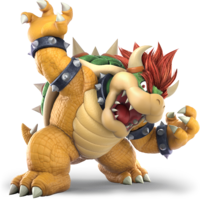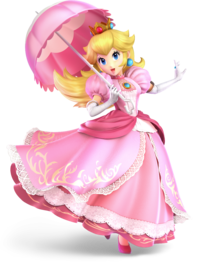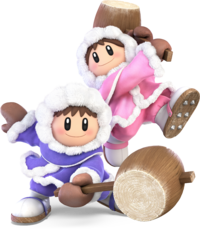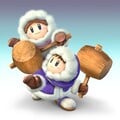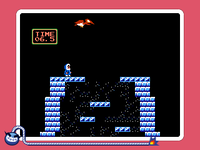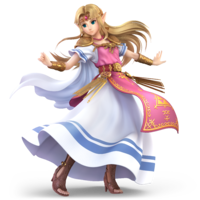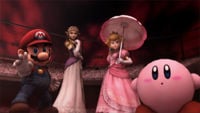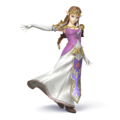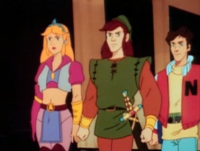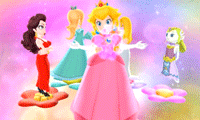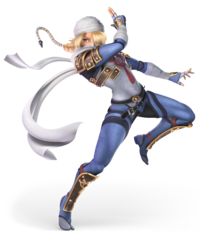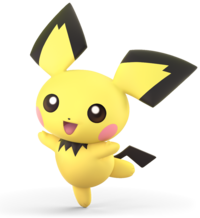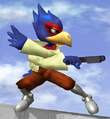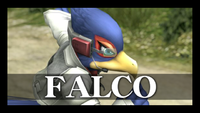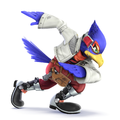List of fighters debuting in Super Smash Bros. Melee
This article is under construction. Therefore, please excuse its informal appearance while it is being worked on. We hope to have it completed as soon as possible.
This is a list of Super Smash Bros. series fighters that debuted in Super Smash Bros. Melee. The page details their role in this series as well as other Mario-related media. Characters from the Mario franchise are covered in detail on their own articles.
See also:
- List of fighters debuting in Super Smash Bros.
- List of fighters debuting in Super Smash Bros. Brawl
- List of fighters debuting in Super Smash Bros. for Nintendo 3DS and Super Smash Bros. for Wii U
- List of fighters debuting in Super Smash Bros. Ultimate
Bowser
- Main article: Bowser § Super Smash Bros. series|Bowser § Super Smash Bros. series|Bowser § Super Smash Bros. series
In most of his Super Smash Bros. series appearances, Bowser appears as a default character, while in Super Smash Bros. Ultimate, he is unlockable.
Peach
- Main article: Peach § Super Smash Bros. series|Peach § Super Smash Bros. series|Peach § Super Smash Bros. series
In most of her Super Smash Bros. series appearances, Peach appears as a default character, while in Super Smash Bros. Ultimate, she is unlockable.
Ice Climbers
- This article is about the recurring duo in the Super Smash Bros. series. For the WarioWare: D.I.Y. microgame, see Ice Climbers (microgame).
- "Ice Climber" redirects here. For the microgame from WarioWare, Inc.: Mega Microgame$!, see Ice Climber (WarioWare, Inc.: Mega Microgame$!). For the microgame from WarioWare: Twisted!, see Ice Climber (WarioWare: Twisted!).
Template:Quote2 The Ice Climbers, named Ice Climber in Japan, are a pair consisting of a boy named Popo and a girl named Nana, who originate from the VS. System arcade game VS. Ice Climber. Though they have only had one single game of their own, aside from the modified NES home conversion Ice Climber, they have made frequent crossover appearances in other Nintendo games, including Game & Watch Gallery 4, WarioWare: Twisted!, WarioWare: Touched!, Tetris DS, a mention in Game & Watch Gallery 3, and another appearance in NES Remix. Both Ice Climbers are playable fighters in Super Smash Bros. Melee, Super Smash Bros. Brawl, and Super Smash Bros. Ultimate.
Super Smash Bros. series
Super Smash Bros. Melee
Template:Main-external The Ice Climbers appear as a new, playable default character in Super Smash Bros. Melee. The two are unique, as they fight as a team, but act as two separate characters. Depending on the alternate costume, the player can control either Popo or Nana, while the other is a computer player that copies their inputs and returns to the player when they are separated. The Ice Climbers attack simultaneously, and as they are two characters the player can grab two opponents and hold two items at once. If the second climber is KO'd, the leading one can still fight, but their attacks are not as powerful as they would be if both are present. However, if the player-controlled climber is KO'd, they are both sent back to the respawn platform. Also unique to the Ice Climbers is that they have normal traction on slippery ground.
Their neutral special move is Ice Shot, which sends out icicles toward the opponents. Their side special is Squall Hammer, in which the climbers spin around with their hammers. Their down special move is Blizzard, which has Popo and Nana send out a blast of cold air, briefly freezing an opponent if the opponent has high enough damage. Their up special move is Belay, in which one of the climbers throws the others into the air with a rope to pull the other up while damaging anyone who gets in the way of the attack; both Ice Climbers are put into a helpless state once the move finishes.
Both Popo and Nana are voiced by Sanae Kobayashi.
Gallery
Super Smash Bros. Brawl
Template:Main-external The Ice Climbers return to the series in Super Smash Bros. Brawl, retaining their moveset and attributes from Super Smash Bros. Melee. However, both Ice Climbers are able to grab a ledge at the same time; in the previous game, the other climber cannot grab on if one is already on the ledge. Their Final Smash is Iceberg, in which they create a large iceberg in the middle of the stage; it freezes any platform in the surrounding area and damages any opposing player who touches the iceberg, doing a heavy amount of damage and sometimes freezing them. Players can attack the iceberg to shrink it, though the iceberg shrinks completely after a period of time.
The Subspace Emissary
The Ice Climbers were first seen climbing up the Glacial Peak, completely oblivious to the shootout between the Great Fox and the Battleship Halberd. However, they do see Meta Knight climbing past them, trying to get to the Halberd. The Ice Climbers see this as a challenge, and race him to the top, managing to reach it first. However, they discover the Aura Pokémon Lucario up there, who challenges Meta Knight. Popo and Nana could only watch. Just after the battle, the Halberd rams the Great Fox into the mountain. While Meta Knight and Lucario take this chance to get inside the Halberd, the Ice Climbers fall into the Canyon, where they find themselves with Marth, Lucas, the Pokémon Trainer, and Ike. The Subspace Army attacks them all, but they are saved by Mario, Link, Yoshi, Kirby, and Pit. The Ice Climbers eventually go to Subspace with all of the heroes, where they all get turned into trophies by Tabuu. Fortunately, Kirby is then revived by a badge created by King Dedede, so he saves Popo and Nana along with some other characters. The entire team then goes after Tabuu.
Gallery
Link gets frozen by Blizzard
Audio samples
| File info |
| File info |
Super Smash Bros. for Nintendo 3DS / Super Smash Bros. for Wii U
The Ice Climbers do not return as playable characters in Super Smash Bros. for Nintendo 3DS and Super Smash Bros. for Wii U, making them the only playable characters in the entire series that have been playable in more than one game before being cut. The director of the games, Masahiro Sakurai, has stated this is because they were unable to run smoothly on the Nintendo 3DS version of the game, and that while the Ice Climbers were running perfectly in the Wii U version, they were cut as they were unlikely to get a new game and Sakurai didn’t want the Wii U version to have an exclusive character. Instead, they appear as a trophy in both versions of the game; the trophy is a random unlockable in Super Smash Bros. for Nintendo 3DS; to unlock the trophy in Super Smash Bros. for Wii U, the player has to KO his/her rival four times in a single Rival Smash match.
Icicle Mountain's theme from Super Smash Bros. Melee and Ice Climbers' theme from Super Smash Bros. Brawl returns in the Wii U version as alternate themes for the Wrecking Crew stage, despite the characters being cut.
On a side note, the Polar Bears from their series appear as enemies in the 3DS-exclusive game mode, Smash Run.
Super Smash Bros. Ultimate
Template:Main-external The Ice Climbers, alongside all Super Smash Bros. series veterans, return as unlockable playable fighters in Super Smash Bros. Ultimate. They received many aesthetic changes, such as Nana being more expressive when Popo grabs an opponent, or vice-versa. The Ice Climbers also have 8 costumes, like all other characters in the game. On a side note, the Ice Climbers' victory theme has been shortened compared to Super Smash Bros. Brawl.
The Ice Climbers retain their Final Smash from Super Smash Bros. Brawl, though it functions slightly differently.
Classic Mode route
| Duos for Days | ||||
|---|---|---|---|---|
| Round | Opponent(s) | Stage | Song | |
| 1 | Link, Zelda | Great Plateau Tower | Main Theme - The Legend of Zelda: Breath of the Wild | |
| 2 | Ryu, Ken | Suzaku Castle | Ryu Stage | |
| 3 | Villager, Isabelle | Smashville | Title Theme - Animal Crossing: Wild World (Brawl) | |
| 4 | Donkey Kong, Diddy Kong | Jungle Japes | Jungle Level (Melee) | |
| 5 | Palutena, Pit | Palutena's Temple | Title Theme - Kid Icarus | |
| 6 | Mario, Peach | Princess Peach's Castle | Main Theme - New Super Mario Bros. | |
| Final | Master Hand, Crazy Hand | Final Destination | Master Hand / Crazy Hand | |
Gallery
WarioWare series
Popo makes a number of appearances in the WarioWare series in microgames based on Ice Climber. The player controls Popo in the Ice Climber microgame in WarioWare, Inc.: Mega Microgame$! and WarioWare Gold, the Ice Climber microgame in WarioWare: Twisted!, and the Ice Climbers microgame in WarioWare: D.I.Y. In WarioWare: Touched!, Popo appears as the sprite in the third level of 8-Bit Hero. In WarioWare: Get It Together!, he makes a cameo in the Ice Climber microgame, where he is seen hanging onto the condor.
Super Mario Maker
The Ice Climbers appear as one of the add-on Mystery Mushroom costumes that are unlocked after completing an Event Course titled "Popo & Nana's Climbing Challenge" in Super Mario Maker. Their animations and sound effects are taken directly from their original game.
Names in other languages
Ice Climbers
| Language | Name | Meaning |
|---|---|---|
| Japanese | アイスクライマー Aisu Kuraimā |
Ice Climber |
| Chinese | 雪人兄弟 Xuěrén Xiōngdì 翻越冰山者 (Super Smash Bros. Ultimate) Fānyuè Bīngshān Zhě |
Snowman Brothers Ice Mountaineers |
| Korean | 얼음 타기 Eol'eum Tagi |
Ice Climbing (mistranslation of "Ice Climbers") |
| Russian | Альпинисты Al'pinisty |
Alpinists |
Popo and Nana
| Language | Name | Meaning |
|---|---|---|
| Japanese | ポポとナナ Popo to Nana |
Popo and Nana |
| Chinese | 波波和娜娜 Bōbō hé Nànà |
Popo and Nana |
| Dutch | Popo en Nana |
Popo and Nana |
| German | Pepe und Nana |
Popo and Nana |
| Korean | 포포 와 나나 Popo wa Nana |
Popo and Nana |
| Russian | Попо и Нана Popo i Nana |
Popo and Nana |
| Spanish | Popo y Nana |
Popo and Nana |
Zelda
- "Zelda" redirects here. For the WarioWare: D.I.Y. microgame, see Zelda (microgame).
Template:Quote2 Princess Zelda is a major character and the titular character of The Legend of Zelda series created by Nintendo. Many different incarnations of Zelda have existed throughout the course of the series, but they commonly share traits such as they all rule over the kingdom of Hyrule, and they all have the power of the Triforce of Wisdom within them. The plot of her series is that she and Link must protect the kingdom of Hyrule from Ganon and prevent him from obtaining the two pieces of the Triforce not inside him.
Though her series is named after her, the starring role in the games is Link. Zelda serves as more of the series' equivalent of Princess Peach, but she usually has active supporting roles in the plot, sometimes even being somewhat of a sidekick to Link, rather than being solely a damsel-in-distress. For example, in The Legend of Zelda: Ocarina of Time, Zelda disguises herself as her alter-ego Sheik to aid Link without revealing her true identity to him.
Super Smash Bros. series
Super Smash Bros. Melee
Template:Main-external Zelda is one of the newcomers introduced in Super Smash Bros. Melee. Her design is based upon her appearance as an adult in The Legend of Zelda: Ocarina of Time. She is a tall lightweight character with slow movement but powerful attacks.
Zelda's moveset mostly uses her magical abilities, while her special moves are mostly based on the spells Link can acquire in The Legend of Zelda: Ocarina of Time. Her neutral special move is Nayru's Love, which puts up a magical barrier that reflects attacks and damages opponents. Her side special is Din's Fire, which launches a fireball that explodes after a time; if the move is performed in the air, Zelda is left helpless immediately after the explosion. Her up special move is Farore's Wind, which causes her to disappear and reappear higher a distance away, being able to damage opponents with both the initial warp and her reappearance; Sheik also has a similar move for her up special move called Vanish. Finally, Zelda's down special is Transform, which causes Zelda to turn into Sheik, giving her a completely different moveset; however, taking damage while the move is in progress immediately cancels the transformation.
Zelda also appears in Stage 3 of Adventure Mode where she is fought on the second part.
Gallery
Super Smash Bros. Brawl
Template:Main-external Zelda returns as a default fighter for Super Smash Bros. Brawl. Her design in this game is based on her appearance in The Legend of Zelda: Twilight Princess. While Zelda's moveset has not been changed, her Final Smash is Light Arrow, which fires a Light Arrow that strikes any opponents in its path, even going through opponents' shields as well as any walls and obstacles. This Final Smash is shared with Sheik.
Zelda's attacks deal more damage and higher knockback than before, but her attacks' strongest hitboxes are smaller in size while her mobility remains abysmal.
The Subspace Emissary
Zelda and Peach were watching Mario and Kirby. However, at the arrival of the Halberd, both princesses ran down to assist them after the arrival of the Primid. However, Zelda is soon captured by Petey Piranha and put into a cage along with Peach. Kirby, who battles Petey Piranha, has the choice to rescue either Peach or Zelda.
If Zelda is not rescued, Wario appears and uses a Dark Cannon to transform her into a trophy and runs off with her. She is later seen on Wario's Cargo alongside Ness, who was also turned into a trophy by Wario shooting a Dark Cannon. However, King Dedede distracts Wario by turning Luigi into a trophy and using him to lure Wario off the Cargo. Dedede steals the Cargo, takes back Luigi, and drives off. Link later spots Zelda on the Cargo before Dedede takes Mario and Pit, who were defeated by Link and Yoshi just prior. Although he loses both his newly acquired trophies to Kirby, and the engine of the Cargo is then wrecked by Pit, Dedede manages to get away with the remaining trophies he does have and makes it to his castle, where he pins badges on Luigi, Ness, and Zelda to revive them later. Unfortunately, Bowser arrives, steals Zelda and brings her to the Halberd, having a short scuffle with Mario's team along the way (and causing Zelda to lose her badge to Kirby).
If Zelda is rescued, she will team up with Kirby and escape the stadium the Warp Star right before it explodes. They fly through the sky, and are chased by the Halberd, which both Kirby and Zelda land on. However, the Arwing with Fox McCloud inside is also following the Halberd. The Halberd shoots down the Arwing which falls down and crashes into the duo, and soon, Kirby and Zelda are back on the ground now in a grassland. While Kirby wanders off looking at other things, Zelda is shot by Bowser and she turns into a trophy. Bowser sends Shadow Bugs which take over Zelda and clones her.
False Zelda takes out a Dark Cannon and tries to shoot Link and Yoshi, however is stopped by Pit and Mario. False Zelda and the two fight however she is soon defeated and turned into a trophy, which soon dissolves. However, Link saw this and thinks that Mario is a member of the Subspace Army and that he killed Zelda, so he tries to turn Mario and Pit into a trophy with Yoshi's help. They are both defeated, however, and taken by King Dedede before Kirby's intervention, after which Link attacks the Cargo's engine.
Regardless of whether or not she is rescued from Petey Piranha, she still ends up in the Halberd with Peach. Meta Knight soon arrives with Lucario and Solid Snake as his entourage, fighting off both False Zelda and False Peach before freeing the real princesses. Zelda then goes off on her own with Peach until they are united by Fox, Falco Lombardi, Lucario, and Snake to fight Duon and have Mr. Game & Watch join their team, and Meta Knight retakes the Halberd. She then goes into Subspace and finds Tabuu, but is turned into a trophy along with everyone else by him soon after, leaving it up to Kirby, revived by the badge from earlier, to revive her. If Kirby also rescued Link, then both of them will revive Ganondorf, who learns of Tabuu and joins the other heroes into the Great Maze.
Gallery
Zelda transforming to avoid Cook Kirby
Zelda's snapshot in The Subspace Emissary, alongside Peach
Zelda transformed into a trophy by Wario
Super Smash Bros. for Nintendo 3DS / Super Smash Bros. for Wii U
Template:Main-external Zelda returns as a playable character in Super Smash Bros. for Nintendo 3DS and Super Smash Bros. for Wii U, retaining her appearance from The Legend of Zelda: Twilight Princess that was used in Super Smash Bros. Brawl. Although Sheik also returns, they are now completely separate characters who cannot transform into each other; her down special attack is instead Phantom Slash, which summons a Phantom from The Legend of Zelda: Spirit Tracks to charge forward and attack.
Gallery
Super Smash Bros. Ultimate
Template:Main-external Zelda returns in Super Smash Bros. Ultimate, as an unlockable playable character alongside the other previous fighters. In this game, her design is primarily based on her alternate dress artwork from The Legend of Zelda: A Link to the Past, with elements from The Legend of Zelda: A Link Between Worlds. Like many other characters, Zelda is more expressive; in fact, she is given much more cheerful and energetic expressions compared to her predecessors. She also has a new Final Smash, which involves trapping opponents with the Triforce of Wisdom. Like her fellow The Legend of Zelda fighters, Zelda's victory theme has been changed to a new arrangement of their home series' main theme.
Zelda benefits from the game's universal changes: her mobility is considerably faster, no longer being one of the slowest characters in the game; her short hop timing is reduced; her attacks have less landing lag; she can directionally air dodge once again; and she can use any grounded attack out of a run and any aerial attack while climbing ladders. In addition, Zelda's special attacks receive many improvements while her attacks deal either more damage or knockback, and have lower start-up or ending lag. Din’s Fire no longer leaves Zelda helpless when in midair.
In addition, Zelda appears in the World of Light's opening cutscene, where she is firstly shown along with Marth and Pit; she then tries to reflect Galeem's large laser attack along with Mewtwo, but fails, with both of them getting eliminated by the lasers and turned into dark clones. She was among the fighters who were brought under Dharkon's control after Galeem's first defeat, and represents the Triforce of Wisdom section of the Sacred Land, referencing her home series. She must then be awoken in the area to progress the story, along with Young Link, Ganondorf, Sonic and Cloud.
Classic Mode route
| Wisdom Prevails | ||||
|---|---|---|---|---|
| Round | Opponent(s) | Rule | Stage | Song |
| 1 | Wario | Great Plateau Tower | Main Theme - The Legend of Zelda: Breath of the Wild | |
| 2 | Bowser | Skyloft | Ballad of the Goddess | |
| 3 | Mii Swordfighter (Yiga Clan outfit) ×5 | Horde Battle | Temple | Temple Theme |
| 4 | Giant King K. Rool | Bridge of Eldin | Dark World (for 3DS / Wii U) | |
| 5 | Dark Samus | Gerudo Valley | Hidden Mountain & Forest | |
| 6 | Link (dark costume) ×2 | Hyrule Castle | Great Temple / Temple | |
| Final | Ganondorf Ganon |
Calamity Ganon Battle - Second Form Death Mountain | ||
Gallery
DIC cartoons
The Legend of Zelda
The Legend of Zelda series received its own animated television series with The Legend of Zelda, produced by DiC Entertainment. It aired under the The Super Mario Bros. Super Show! syndication, with the animated Mario segments running Monday through Thursday, and being replaced by Zelda segments on Fridays. The Zelda segments still received an accompanying live-action Mario and Luigi short. The series revolved around Link and Princess Zelda protecting the Triforce of Wisdom from Ganon. Cynthia Preston (credited as Cyndy Preston) voiced Princess Zelda in the series.
Captain N: The Game Master
Link and Zelda appear in Captain N: The Game Master, borrowing their appearance and personality from The Legend of Zelda television series. Cynthia Preston (credited as Cyndy Preston) returned to voice Princess Zelda in the series.
Mario Artist: Paint Studio
Young and adult artwork of Princess Zelda from The Legend of Zelda: Ocarina of Time can be used as a stamp in Mario Artist: Paint Studio.
Game & Watch Gallery 4
In Game & Watch Gallery 4, Zelda appears in the Zelda Game & Watch game, which is playable in the Museum after unlocking enough stars. This game is a remake of the Zelda Game & Watch game in which Link must battle monsters, including dragon bosses, in order to collect pieces of the Triforce and thus free Zelda.
StreetPass Mii Plaza
Two incarnations of Zelda, each based on her respective appearances in The Legend of Zelda: Skyward Sword and The Legend of Zelda: The Wind Waker, appears on the Puzzle Swap panel "Nintendo Starlets" of the StreetPass Mii Plaza, alongside Princess Peach, Pauline and Rosalina.
Super Mario Maker
Zelda appears as a Mystery Mushroom costume in Super Mario Maker. Zelda's costume can be unlocked by scanning her respective amiibo or randomly by completing the 100 Mario Challenge on Expert difficulty or higher. She retains her The Legend of Zelda: Twilight Princess appearance from Super Smash Bros. Brawl and Super Smash Bros. for Nintendo 3DS / Wii U in this game.
Additionally, costumes based on Sheik and Tetra are also available, both of which involve Zelda as part of their poses.
Portrayals
Zelda was originally voiced by Jun Mizusawa in her first three Super Smash Bros. appearances, matching her appearances in both The Legend of Zelda: Ocarina of Time and The Legend of Zelda: Twilight Princess, but was replaced for the first time in series by Ayumi Fujimura in Super Smash Bros. Ultimate, who previously voiced her in The Legend of Zelda: A Link Between Worlds, applying a similar situation to what Link and Ganondorf received in Super Smash Bros. Brawl and Super Smash Bros. Ultimate.
On a side note, the opening cutscene for the World of Light in Ultimate marks the first time in the series where Zelda has fully spoken lines (quoted above). During this, she is voiced in the English release by Brandy Kopp, who also voiced Palutena starting from the previous game, in a similar vein to how Fox and Falco are dubbed exclusively in Smash Taunts in Super Smash Bros. Melee; thus making her one of the few characters to have two voice actors in one game.
Gallery
Japanese commercial for Wario's Woods on Famicom
Names in other languages
| Language | Name | Meaning |
|---|---|---|
| Japanese | ゼルダ姫 Zeruda Hime |
Princess Zelda; referred to as simply「ゼルダ」in-game |
| Chinese (simplified) | 塞尔达公主 Sài'ěrdá Gōngzhǔ |
Princess Zelda; referred to as simply "薩爾達" or "塞尔达" in-game, unlike Peach and Daisy |
| Chinese (traditional) | 薩爾達公主 Sài'ěrdá Gōngzhǔ |
Princess Zelda; referred to as simply "薩爾達" or "塞尔达" in-game, unlike Peach and Daisy |
| Dutch | Prinses Zelda |
Princess Zelda |
| German | Prinzessin Zelda |
Princess Zelda |
| Greek | Πριγκίπισσα Ζέλντα Prigipissa Zelda |
Princess Zelda |
| Italian | Principessa Zelda |
Princess Zelda |
| Korean | 젤다 공주 Jelda Gongju |
Princess Zelda |
| Portuguese | Princesa Zelda |
Princess Zelda |
| Russian | Принцесса Зельда Printsessa Zelda |
Princess Zelda |
| Spanish | Princesa Zelda |
Princess Zelda |
Sheik
- This section is about Zelda's alter ego. For mouse character from Paper Mario, see Sheek.
Template:Quote2 Sheik is the alter ego of Princess Zelda featured in The Legend of Zelda: Ocarina of Time. Throughout the game, Sheik would appear unexpectedly and aid Link in his quest in defeating Ganondorf. Link (and the player) do not discover that Sheik is Zelda, until near the game's finale. Her appearance is very androgynous, and was made that way in order to make the reveal at the end more surprising. Because of this, she has been referred to as both male and female by other characters as well as in certain descriptions, but is canonically female. She serves as a playable fighter in the Super Smash Bros. series, starting with Super Smash Bros. Melee. In the first two games, using the Transform move, Zelda could become Sheik mid-battle, but in the Nintendo 3DS and Wii U games and Super Smash Bros. Ultimate, Sheik is a separate character.
Super Smash Bros. series
Super Smash Bros. Melee
Template:Main-external
In Super Smash Bros. Melee, Zelda is able to use her down special move Transform to turn herself into Sheik at any point, or automatically at the start of a match by holding down ![]() on the stage select screen, giving her a completely different moveset and playstyle. Compared to Zelda, Sheik is more agile, with quick movements and attacks, but she lacks Zelda's power. The lone exception is her up smash, which has a sweetspot that can hit twice for about 30%. Sheik is voiced by Jun Mizusawa (up until Super Smash Bros. for Nintendo 3DS and Super Smash Bros. for Wii U), who also did the voice of her counterpart, Zelda. Sheik (along with Ganondorf and Roy) does not appear as an opponent in the game's Classic Mode, though she can appear as an ally in Team and Giant battles. As a result, her introduction image for Classic Mode goes unused. However, Sheik can be fought if the opponent is Zelda and transforms into Shiek.
on the stage select screen, giving her a completely different moveset and playstyle. Compared to Zelda, Sheik is more agile, with quick movements and attacks, but she lacks Zelda's power. The lone exception is her up smash, which has a sweetspot that can hit twice for about 30%. Sheik is voiced by Jun Mizusawa (up until Super Smash Bros. for Nintendo 3DS and Super Smash Bros. for Wii U), who also did the voice of her counterpart, Zelda. Sheik (along with Ganondorf and Roy) does not appear as an opponent in the game's Classic Mode, though she can appear as an ally in Team and Giant battles. As a result, her introduction image for Classic Mode goes unused. However, Sheik can be fought if the opponent is Zelda and transforms into Shiek.
Sheik's standard special move is Needle Storm, in which she gathers and tosses needles at opponents. Her side special move is Chain, in which she tosses a chain that can grab opponents. Her up special move is Vanish, in which, similarly to Zelda's Farore's Wind, Sheik disappears in an explosion and reappears in a different location depending on the direction held. Finally, her down special move is Transform, which turns her back into Zelda; taking damage while the move is in progress immediately cancels the transformation. Sheik ends up sending opponents flying vertically with the Home-Run Bat; therefore, she needs to transform into Zelda to use the Home-Run Bat properly in the Home-Run Contest.
According to the Star Rod's trophy information, it has most power when Sheik or Captain Falcon perform a smash attack with it.
Unlike the other The Legend of Zelda characters, Sheik can actually speak, though this is exclusive to the Japanese version of Super Smash Bros. Melee.
Gallery
Audio samples
| File info |
Super Smash Bros. Brawl
Template:Main-external Sheik returns in Super Smash Bros. Brawl, with the same role as before. Matching with Zelda's design, Sheik's design in this game is based on The Legend of Zelda: Twilight Princess. In this game, Sheik can now be chosen from the character select screen, by choosing Zelda and selecting Sheik's portrait.
Sheik retains weak attacks and a powerful up smash; her down smash, however, can now hit twice, allowing for 23% damage. Many of Shiek's attacks deal less knockback, but her mobility is improved as compensation.
Sheik can now wall jump and crawl; additionally, her Chain move can be used as a tether recovery. In addition, she shares her Final Smash with Zelda, Light Arrow, though Sheik's Light Arrow deals greater damage and knocks back at a more horizontal angle than Zelda's.
The Subspace Emissary
At any point in The Subspace Emissary at which the player can control Zelda, they can transform into Sheik using the Transform move, and vice versa. However, Sheik is not properly introduced until later in the story.
After being turned into trophies and kidnapped, Peach and Zelda are being held in cages in the Halberd, until they are freed by Meta Knight, Lucario, and Snake. Snake tells them to stay where they are, but Zelda transforms into Shiek and sneaks out of the room with Peach, moving around the outside of the Halberd until they reach the main deck. While Fox is battling the Halberd in his Arwing, he almost blasts Peach, prompting Sheik to appear on top of his Arwing and attack him. Both of them leap down onto the bridge and start to fight, but Peach stops them by offering them both tea. While this is happening, Snake punches the Mr. Game & Watch copies onto the deck from the bridge, the Shadow Bugs forming together into Duon. Sheik, Fox, and Peach, along with Snake, Lucario, and Falco, fight Duon, and after it is defeated the Trophy of the actual Mr. Game & Watch appears, which Peach returns to normal. After this point, the rest of The Subspace Emissary's storyline features Zelda.
Gallery
Super Smash Bros. for Nintendo 3DS / Super Smash Bros. for Wii U
Template:Main-external Template:Quote2 Sheik is now a separate character from Zelda in Super Smash Bros. for Nintendo 3DS and Super Smash Bros. for Wii U. This means she and Zelda can no longer transform between each other. Instead of transforming, her down special move is now a move called Bouncing Fish, in which she leaps with a backflip and strikes with the heel of her foot, dealing high knockback to the opponent while Sheik rebounds backwards in a higher arc than the original. In addition, her side special has been changed to Burst Grenade, in which she tosses a small grenade attached to a string that pulls in nearby opponents and explodes after a certain time. While performing Vanish, the Deku Nut explosion and Sheik's reappearance can now damage opponents. Like many other veteran characters in the game, Sheik's mobility has significantly improved from Super Smash Bros. Brawl; on the flipside, her overall damage output is toned down to a degree.
Gallery
Super Smash Bros. Ultimate
Template:Main-external Sheik returns in Super Smash Bros. Ultimate this time as an unlockable playable character. She has a new Final Smash, Sheikah Dance, in which she stuns any opponents in front of her (as the Sheikah symbol briefly appears) and deals multiple slashes with her knife while constantly vanishing and reappearing around them, culminating with a final blow that launches them away, similarly to Young Link and Toon Link's Triforce Slash and Cloud's Omnislash. Her outfit in this game resembles the Stealth Chest Guard and Stealth Tights from The Legend of Zelda: Breath of the Wild. As a result of Zelda's The Legend of Zelda: A Link Between Worlds-based revamps, Ayumi Fujimura now also voices her (replacing Jun Mizusawa), giving Sheik more deeper, masculine voice clips. Like her fellow The Legend of Zelda fighters, Zelda's victory theme has been changed to a new arrangement of their home series' main theme.
Like all other characters in the game, Sheik benefits from universal changes: her already-incredible mobility is improved; her short hop timing is reduced; her aerial attacks have less landing lag; she can directionally air dodge once again; and she can use any grounded attack out of a run and any of her aerials while climbing ladders. However, her damage output receives a harsher downgrade.
Classic Mode route
| Masquerade | ||||
|---|---|---|---|---|
| Round | Opponent(s) | Rule | Stage | Song |
| 1 | Meta Knight | Fountain of Dreams | Forest Stage | |
| 2 | Captain Falcon | Big Blue | Death Wind | |
| 3 | Samus | Norfair | Opening/Menu - Metroid Prime | |
| 4 | Roy | Mushroom Kingdom U | Underground Theme - Super Mario Land | |
| 5 | Little Mac (wire-frame/hoodie costume) | Boxing Ring | Tunnel Theme - X-Scape | |
| 6 | Mii Brawler ×2, Mii Swordfighter ×2, Mii Gunner ×2 | Horde Battle | Final Destination | Meta Crystal |
| Final | Master Hand, Crazy Hand (intensity 7.0 or higher) | Final Destination | Master Hand Master Hand / Crazy Hand (intensity 7.0 or higher) | |
Audio samples
| File info |
Mario Golf
Sheik's name can be seen in both the Nintendo 64 and Game Boy Color versions of Mario Golf on the game scoreboard in Tournament mode.
Mario Artist: Paint Studio
Artwork of Sheik from The Legend of Zelda: Ocarina of Time can be used as a stamp in Mario Artist: Paint Studio.
Super Mario Maker
In Super Mario Maker, one of the 8-bit costumes Mario can receive from a Mystery Mushroom is Sheik, which can be unlocked either with a Sheik amiibo or by clearing 100 Mario Challenge on Normal difficulty. All of Sheik's sounds are from The Legend of Zelda: Ocarina of Time. The costume's transformation sound is the sound clip that plays when collecting an important item. Pressing ![]() will have her turn into Zelda (using her sprite in this game based on The Legend of Zelda: Twilight Princess), which briefly plays "Zelda's Lullaby" as it would sound on Link's ocarina. The sound that plays when she jumps is her voice clip when throwing a Deku Nut before disappearing. The death tune is Sheik's theme, and when clearing a level, the theme in which Link initially meets Zelda plays.
will have her turn into Zelda (using her sprite in this game based on The Legend of Zelda: Twilight Princess), which briefly plays "Zelda's Lullaby" as it would sound on Link's ocarina. The sound that plays when she jumps is her voice clip when throwing a Deku Nut before disappearing. The death tune is Sheik's theme, and when clearing a level, the theme in which Link initially meets Zelda plays.
Names in other languages
| Language | Name | Meaning |
|---|---|---|
| Japanese | シーク Shīku |
Sheik |
| Chinese | 希克 Xīkè |
Sheik |
| German | Shiek |
- |
| Italian | Sheik |
- |
| Korean | 시크 Shikeu |
Sheik |
| Russian | Шейк Шиик (Super Smash Bros. Ultimate) Sheyk Shiik |
Sheik |
| Spanish (NOA) | Sheik |
- |
Dr. Mario
- Main article: Dr. Mario § Super Smash Bros. series|Dr. Mario § Super Smash Bros. series|Dr. Mario § Super Smash Bros. series
Dr. Mario appears as an unlockable fighter in all of his playable appearances in the Super Smash Bros. series.
Pichu
Template:Quote2 Pichu is an Electric-type Pokémon introduced in the games Pokémon Gold and Pokémon Silver. It is the pre-evolved form of Pikachu, the Pokémon mascot. It appears as a playable character in Super Smash Bros. Melee and Super Smash Bros. Ultimate and as a trophy in Super Smash Bros. Brawl and Super Smash Bros. for Nintendo 3DS and is referenced in Palutena's Guidance regarding Pikachu in Super Smash Bros. for Wii U.
Super Smash Bros. Melee
Template:Main-external Pichu is a playable fighter in Super Smash Bros. Melee. It is an unlockable character, unlocked by beating Event Match 37: Legendary Pokémon, or by playing 200 Melee matches. Afterward, Pichu must be defeated in a match on Pokémon Stadium.
Pichu's moveset is similar to Pikachu's, though most of its attacks are weaker, and all of its electrical attacks also deal recoil damage. Pichu is also faster than Pikachu, but is the lightest character in the game, making it easily thrown off the stage. Its neutral special move is Thunder Jolt, which involves Pichu launching a ball of electricity rotating across the stage until it collides with an opponent. Its side special move is Skull Bash, which has Pichu charging up an attack before launching head-first across the screen, attacking any opponent it hits with a headbutt. Its down special move is Thunder, in which Pichu calls down a bolt of lightning that appears from a cloud above it and strikes any fighters in its path to damage them; if the bolt strikes Pichu, any nearby fighters are damaged by it as well. Finally, Pichu's up special move is Agility, allowing Pichu to warp in the direction held on the control stick in a burst of speed, and again if the direction is changed during the move; however, unlike Pikachu's Quick Attack, it does not give as much distance and does not deal damage.
Pichu is the only character in the game to have two taunts, one for each direction it is facing. It is voiced by Satomi Kōrogi in both English and Japanese, who does its voice in the Pokémon anime.
Gallery
Super Smash Bros. Brawl
Pichu is one of the five Super Smash Bros. Melee fighters that did not return as a playable character in Super Smash Bros. Brawl (the other four being Dr. Mario, Young Link, Mewtwo, and Roy). However, the player can get a trophy of Pichu by clearing All-Star Mode without continuing.
Super Smash Bros. for Nintendo 3DS / Super Smash Bros. for Wii U
Pichu appears once again as a collectible trophy in Super Smash Bros. for Nintendo 3DS, while it is referenced in Palutena's Guidance regarding Pikachu in Super Smash Bros. for Wii U.
Super Smash Bros. Ultimate
Template:Main-external Pichu, after being absent as a playable character in every Super Smash Bros. game since Super Smash Bros. Melee, returns as an unlockable playable fighter in Super Smash Bros. Ultimate. Like all other fighters in the game, it has a Final Smash. Pichu's Final Smash, Volt Tackle, functions similarly to Pikachu's identically named move, although Pichu's version does recoil damage to itself, but it is also stronger. Pichu gains a new on-screen appearance and two new taunts, and Pichu can speak during some animations.
Compared to its appearance in Super Smash Bros. Melee, Pichu is faster, its aerial attacks have less landing lag, its short hop timing is reduced, it is heavier, its moveset has attacks that knock opponents back farther, many of its attacks deal more damage to opponents, and it does less damage to itself with electrical attacks (said attacks now cause around 0.4% damage each as opposed to 1–6%). Some of Pichu's attacks, however, are weakened.
Classic Mode route
| Lightweight Fracas | ||||
|---|---|---|---|---|
| Round | Opponent(s) | Rule | Stage | Song |
| 1 | Jigglypuff | Pokémon Stadium 2 | Pokémon Center - Pokémon Red / Pokémon Blue | |
| 2 | Squirtle | Peach's Castle | Road to Viridian City - Pokémon Red / Pokémon Blue | |
| 3 | Mr. Game & Watch | Skyworld | Underworld | |
| 4 | Olimar | Pilotwings | Light Plane | |
| 5 | Kirby, Meta Knight | Free-for-All | Skyloft | Butter Building (for 3DS / Wii U) |
| 6 | Mewtwo | Prism Tower | Pokémon Red / Pokémon Blue Medley | |
| Final | Master Hand, Crazy Hand (intensity 7.0 or higher) | Final Destination | Master Hand Master Hand / Crazy Hand (intensity 7.0 or higher) | |
Audio samples
| File info |
Names in other languages
| Language | Name | Meaning |
|---|---|---|
| Japanese | ピチュー Pichū |
From「ピカピカ」(pikapika, onomatopoeia for sparkling),「チューチュー」(chūchū, onomatopoeia for squeaking mice), and「プチ」(puchi, "little") |
| Chinese | 皮丘 Píqiū |
Pichu |
| Italian | Pichu |
Pichu |
| Korean | 피츄 Pichyu |
Pichu |
| Russian | Пичу Pichu |
Pichu |
| Spanish | Pichu |
Adaptation from Pichū |
Falco
- “Personally, I prefer the air!”
- —Falco Lombardi, Super Smash Bros. Brawl
Falco Lombardi is one of the main protagonists of the Star Fox series, the "ace pilot" of the team Star Fox and, due to his flying skills, the friendly rival of team leader Fox McCloud. He used to be the head of a gang, but bailed out to join the Star Fox team as Fox's second-in-command. Falco leaves the Star Fox team on occasions, and always reappears when needed. He has a very laid back but cocky attitude and is smart mouthed. Despite this, nothing gets in the way of Falco and Fox's friendship.
Shigeru Miyamoto named Falco after Paul Lombardi, the special effects coordinator of the 1993 Super Mario Bros. film, in gratitude for the work he did on the film.[citation needed]
Super Smash Bros. series
Super Smash Bros. Melee
Template:Main-external Falco is a playable fighter in Super Smash Bros. Melee. He is, however, unlockable, and is unlocked by beating 100-Man Melee or by playing 300 Melee matches, and then beating Falco on Battlefield. While his voice clips are mostly provided by Hisao Egawa, Ben Cullum voices Falco during the Adventure Mode Stage 6 cutscene or the Corneria Smash Taunt, and would later provide Falco's voice for Star Fox Adventures.
Falco's moves are exactly the same as Fox's, though his special moves have different attributes. Falco's Blaster has more of a forceful effect but isn't rapid-fire, and his Reflector attack blasts people upwards instead of sideways. His side special, named Falco Phantasm, possesses a meteor smash effect when used in midair though it does not travel as far as Fox's Fox Illusion, and his up special, Fire Bird, does not have as much reach as Fox's Fire Fox but can deal more damage. In addition, Falco has more attack power and jumps higher than Fox, while running slower and falling faster. Falco is also heavier than Fox, though is still one of the lighter characters.
Falco also appears in Stage 6 of Adventure Mode. In this, he, Slippy, and Peppy will appear in their Arwings in the second half of the battle to shoot at both the player and Fox. Additionally, if Falco is unlocked, he will sometimes replace Fox in the second battle, forcing Fox into the Arwing.
Gallery
Audio samples
| File info |
Super Smash Bros. Brawl
Template:Main-external Falco returns as an unlockable character in Super Smash Bros. Brawl. To unlock him, the player must to play 50 Brawl matches, complete 100-Man Brawl, or having him join the party in The Subspace Emissary after clearing The Swamp; using one of the former two methods the player must then beat him on Lylat Cruise to unlock him. His design has been changed, appearing more similarly to his appearance in Star Fox Command rather than Star Fox 64, and is now voiced by Dex Manley for the English version.
Falco's moveset has been altered for this game, differentiating him further from Fox. He kicks his Reflector forward rather than holding it in place, and his Falco Phantasm travels as far as Fox Illusion. His Final Smash is the Landmaster, in which he summons one of the vehicles to drive and attack opponents. Compared to Fox's Landmaster, this vehicle has weaker shots and battering damage, but a stronger barrel roll with less knockback, and the cannon shots deal more damage when opponents are standing on it. It also flies faster than Fox's, though it is the slowest on the ground.
Falco also has a Smash Taunt on the Lylat Cruise stage as well as on the returning Corneria stage.
The Subspace Emissary
In the Subspace Emissary, he appears after Bowser shoots Diddy Kong (and uses him and some Shadow Bugs to create False Diddy Kong) and almost shoots Fox McCloud. Falco comes in with Arwing and jumps out with his guns to shoot and destroy Bowser's Dark Cannon (causing Bowser to retreat) and sees False Diddy Kong, Fox revives Diddy Kong and they all fight the evil clone. After defeat, Falco attempts to leave but Diddy Kong tries to tells him Donkey Kong has been kidnapped and turned into a trophy. Falco however ignores him, so Diddy Kong grabs Falco and drags him, just as he did with Fox when he ignored Diddy Kong. After Falco understands, he jumps inside his Arwing so they can follow Donkey Kong. Falco drops Diddy Kong off on the plane Donkey Kong is on, and he (with Captain Olimar and Captain Falcon) rescues Donkey Kong. Falco flies by in his Arwing giving a thumbs up at Diddy Kong.
After this, he wasn't seen again until the battle at the Battleship Halberd Bridge, where he joins Fox, Princess Peach, Princess Zelda, Lucario, and Solid Snake in defeating Duon. Once all of the teams unite, they enter Subspace, where they are defeated by Tabuu, with Falco being among the victims. King Dedede, however, comes to his aid with the help of Luigi and Ness, who were revived by Dedede's badges and are helping him revive most of the others. The newly revived Falco then heads with the others to stop Tabuu at the Great Maze once and for all.
Gallery
Audio samples
| File info |
Super Smash Bros. for Nintendo 3DS / Super Smash Bros. for Wii U
Template:Main-external Falco returns as a playable character in Super Smash Bros. for Nintendo 3DS and Super Smash Bros. for Wii U, his moveset and appearance being largely unchanged from his Super Smash Bros. Brawl incarnation, though he is now voiced in English by Mark Lund, who voiced Falco in Star Fox 64 3D, and reprised his role in Star Fox Zero and Starlink: Battle for Atlas. In the Nintendo 3DS version, Falco is unlocked by either completing Classic Mode without the use of continues or by playing 20 matches, then defeating Falco in a 1-stock match on the Corneria stage. In the Wii U version, he is unlocked by either completing Classic Mode for the first time or by playing 10 matches, then defeating Falco in a 1-stock match on the Orbital Gate Assault stage.
Falco once again has Smash Taunts on the returning Corneria stage in Super Smash Bros. for Nintendo 3DS, and the returning Lylat Cruise stage in Super Smash Bros. for Wii U. Falco also appears during the conversations on Orbital Gate Assault.
Gallery
- Super Smash Bros. for Nintendo 3DS
- Super Smash Bros. for Wii U
Super Smash Bros. Ultimate
Template:Main-external Falco returns as an unlockable playable character in Super Smash Bros. Ultimate, this time more closely resembling his appearance in Star Fox Zero. Compared to the previous installment, Falco receives improvements, such as increased mobility, decreased landing lag on his aerial attacks, faster special moves, and greater ability to knock opponents back for many of his attacks. However, Falco's damage output is slightly toned down overall. He has a new Final Smash, involving him leading an "unorthodox formation" of Arwings. Mark Lund reprises his role as Falco, though with newly recorded voice clips, such as saying "Come on!" rather than "Get some!" for his side taunt.
Several of Falco's attacks have names: down tilt is Tail Cutter; standard aerial is Spinning Falco Chop; and down aerial is Corkscrew Meteor.
Classic Mode route
| Soar above the Darkness | ||||
|---|---|---|---|---|
| Round | Opponent(s) | Stage | Song | |
| 1 | Dark Samus | Frigate Orpheon | Multiplayer - Metroid Prime 2: Echoes | |
| 2 | Dark Pit | Reset Bomb Forest | Dark Pit's Theme | |
| 3 | Link (dark costume), Toon Link (dark costume) | Bridge of Eldin | Dark World (for 3DS / Wii U) | |
| 4 | Lucas (gray costume) | New Pork City | Porky's Theme | |
| 5 | Captain Falcon (Blood Falcon costume) | Port Town Aero Dive | Devil's Call in Your Heart | |
| 6 | Giant Mr. Game & Watch | Find Mii | Flat Zone | |
| Final | Master Hand (intensity 7.0 or higher), Crazy Hand | Final Destination | Crazy Hand Master Hand / Crazy Hand (intensity 7.0 or higher) | |
Gallery
Audio samples
| File info |
| File info |
Club Nintendo
Falco makes a brief appearance in the German Club Nintendo magazine comic "Super Mario: Verloren in der Zeit". He is watching the Olympics together with Fox and Peppy.
Mario Artist: Paint Studio
A 3D render of Falco from Star Fox 64 can be used like a stamp in Mario Artist: Paint Studio.
Nintendo Monopoly
Falco appears in the 2006 version of Nintendo Monopoly, where he takes the place of Vermont Avenue. He costs $100. In the 2010 version, he is replaced with K.K. Slider from the Animal Crossing series.
Super Mario Maker
Falco appears as a Costume in Super Mario Maker. Falco's costume can be unlocked by scanning his respective amiibo or randomly by completing the 100 Mario Challenge on expert difficulty. His sound clip from the original SNES Star Fox game is used when the player uses the Falco costume.
Quotes
- "Mission complete!" — Super Smash Bros. Melee
- "Hands off my prey!" — Super Smash Bros. Melee (Japanese), Super Smash Bros. Brawl, Super Smash Bros. for Nintendo 3DS, Super Smash Bros. for Wii U, Super Smash Bros. Ultimate
- "Piece of cake!" — Super Smash Bros. Brawl, Super Smash Bros. for Nintendo 3DS, Super Smash Bros. for Wii U, Super Smash Bros. Ultimate
- "Don't try me!" — Super Smash Bros. Brawl
- "You aren't worth the trouble!" — Super Smash Bros. Brawl, Super Smash Bros. for Nintendo 3DS, Super Smash Bros. for Wii U
- "Had enough already?!" — Super Smash Bros. Brawl, Super Smash Bros. for Nintendo 3DS, Super Smash Bros. for Wii U
- "You're off your game, Fox!" — Super Smash Bros. Brawl, Super Smash Bros. for Nintendo 3DS, Super Smash Bros. for Wii U
- "Get some!" — Super Smash Bros. for Nintendo 3DS, Super Smash Bros. for Wii U
- "Sorry, gotta jet!" — Super Smash Bros. Ultimate
- "Showtime!" — Super Smash Bros. Ultimate
- "We've got multiple bogies inbound!" — Super Smash Bros. Ultimate
- "Time for a little payback!" — Super Smash Bros. Ultimate
Names in other languages
| Language | Name | Meaning |
|---|---|---|
| Japanese | ファルコ・ランバルディ Faruko Ranbarudi |
Falco Lombardi |
| Chinese | 法爾科・蘭巴帝 Fǎěrkē Lánbādì |
Falco Lombardi |
| Korean | 팔코 람바디 Palko Rambadi |
Falco Lombardi |
| Russian | Фалько Ломбарди Falko Lombardi |
Falco Lombardi |
| Spanish | Falco Lombardi |
- |
